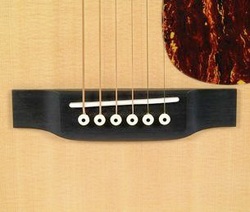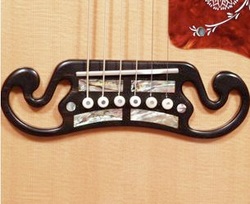
Guitar Belly Bridge
About the most fundamental part in the tone-production chain of command, of the acoustic and classical guitar, is the Guitar Bridge.
Whenever the Guitar Bridge is not constructed properly, installed properly or not constructed of the proper materials, it can cause the luthier a considerable amount of grief and the result is a guitar that has poor volume and tone production qualities.
What is the First Role of the Guitar Bridge?
The most important purpose of the Guitar Bridge is to provide an efficient and secure bond of the guitar strings to the top of the guitar. To endure the virtually 200 pounds of loading placed on the guitar by the guitar strings, the bridge needs to be very secure and efficient.
What is the Secondary Purpose of the Guitar Bridge?
Secondly, and no less important, it is the job of the guitar bridge to effectively communicate the tone and vibrations of the strings to the guitar top while the strings are played.
The Final Role of the Bridge:
The concluding role of the guitar bridge is simply a cosmetic one. The intent of the guitar bridge plays a substantial role in the overall expression of the finished guitar.
Whenever the Guitar Bridge is not constructed properly, installed properly or not constructed of the proper materials, it can cause the luthier a considerable amount of grief and the result is a guitar that has poor volume and tone production qualities.
What is the First Role of the Guitar Bridge?
The most important purpose of the Guitar Bridge is to provide an efficient and secure bond of the guitar strings to the top of the guitar. To endure the virtually 200 pounds of loading placed on the guitar by the guitar strings, the bridge needs to be very secure and efficient.
What is the Secondary Purpose of the Guitar Bridge?
Secondly, and no less important, it is the job of the guitar bridge to effectively communicate the tone and vibrations of the strings to the guitar top while the strings are played.
The Final Role of the Bridge:
The concluding role of the guitar bridge is simply a cosmetic one. The intent of the guitar bridge plays a substantial role in the overall expression of the finished guitar.
Title.

Gibson Guitar Mustache Bridge
Types of Guitar Bridges:
There are 3 basic varieties of guitar bridges that are used for the acoustic guitar. The classical guitar bridge was designed in the mid-1800's by the famous guitar builder, Antonio De Torres and his original design has be utilized on virtually every classical guitar since that time.
The major components of the classical guitar are the saddle capture component, the bridge tie block and the bridge wings, which help transfer the vibrations of the strings to the guitar top and top braces. The classical guitar relies completely on a glue joint to attach the bridge to the guitar top.
The Belly Bridge:
The bridge of choice for guitar manufacturers and luthiers alike is the acoustic guitar belly bridge. In the early 1930's the CF Martin Company designed the belly bridge as part of their introduction of the Dreadnought Guitar line.
The timeless beauty of the belly bridge has been a fundamental reason for it's popularity over these countless years. The belly bridge features a captured saddle, delicately curved wing ramps, and of course the belly plan-form.
Acoustic Guitar Prism Bridge:
Again, this was rolled-out by CF Martin and is now used on their Vintage re-issue guitars. There are various differences between the belly bridge such as a rectangular plan-form, prism-shaped ramps and a through saddle. The most common attachment method for the prism type of Guitar Bridge is by means of a glue joint alone.
The Mustache Bridge:
This was introduced by The Gibson Guitar Co. It was utilized in many of their acoustic guitars introduced during what is known as the 'pre-war series', which means prior to WWII.
The mustache bridge is equivalent to the belly bridge in that it utilizes a captured saddle, but the plan-form is very distinctive and mustache-shaped, where it gets its name.
The bridge pin shape is normally fan-shaped or in an curve. The most common fastening method for the mustache bridge is by a glue joint combined with mechanical fasteners.
That is it for the basics on the conventional Guitar Bridge. These are bridges of choice for nearly all guitar builders.
There are 3 basic varieties of guitar bridges that are used for the acoustic guitar. The classical guitar bridge was designed in the mid-1800's by the famous guitar builder, Antonio De Torres and his original design has be utilized on virtually every classical guitar since that time.
The major components of the classical guitar are the saddle capture component, the bridge tie block and the bridge wings, which help transfer the vibrations of the strings to the guitar top and top braces. The classical guitar relies completely on a glue joint to attach the bridge to the guitar top.
The Belly Bridge:
The bridge of choice for guitar manufacturers and luthiers alike is the acoustic guitar belly bridge. In the early 1930's the CF Martin Company designed the belly bridge as part of their introduction of the Dreadnought Guitar line.
The timeless beauty of the belly bridge has been a fundamental reason for it's popularity over these countless years. The belly bridge features a captured saddle, delicately curved wing ramps, and of course the belly plan-form.
Acoustic Guitar Prism Bridge:
Again, this was rolled-out by CF Martin and is now used on their Vintage re-issue guitars. There are various differences between the belly bridge such as a rectangular plan-form, prism-shaped ramps and a through saddle. The most common attachment method for the prism type of Guitar Bridge is by means of a glue joint alone.
The Mustache Bridge:
This was introduced by The Gibson Guitar Co. It was utilized in many of their acoustic guitars introduced during what is known as the 'pre-war series', which means prior to WWII.
The mustache bridge is equivalent to the belly bridge in that it utilizes a captured saddle, but the plan-form is very distinctive and mustache-shaped, where it gets its name.
The bridge pin shape is normally fan-shaped or in an curve. The most common fastening method for the mustache bridge is by a glue joint combined with mechanical fasteners.
That is it for the basics on the conventional Guitar Bridge. These are bridges of choice for nearly all guitar builders.
